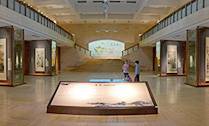The painting and calligraphy of Dong Qichang
Release time:14-06-27
Foreword
Dong Qichang (1555—1636), style name Xuanzai, pseudonyms Sibai, Xiangguang Jushi, posthumous title Wenmin, was Born in Huating (today’s Songjiang of Shanghai). He was a noted painter, calligrapher and art theorist in the late Ming Dynasty.
Most of Dong’s paintings were landscapes, who modeled himself after masters such as Dong Yuan, Ju Ran, Huang Gongwang and Ni Zan. His style was elegant and mild, tranquil and open. His calligraphies were primitive and plain, unrestrained and simple, featuring a very strong approach of the Jin and Song Dynasties. Dong paid special attention to imitate his ancestors in painting and calligraphy, yet being creative at the same time. He had practiced himself with perfect skills before he created something of his own, showing a naïve and unsophisticated personality in his literati paintings. As the founder of the Songjiang Painting School, Dong also had a high political status, and finally his calligraphic and painting style became dominant during the late Ming to early Qing Dynasties.
The art theories of Dong Qichang epitomized major viewpoints of his ancestors yet still struck out a new path. He summarized the history of landscape paintings, and reviewed masters of the Tang Dynasty, the Five Dynasties, and the Song and Yuan Dynasties. Dong raised the noted Southern and Northern Origins Theory, which divided painting styles into the Southern and Northern genres and emphasized the painter’s morality and ideology. This Theory promoted literati paintings and had a positive effect on the development of Chinese paintings but meanwhile, encouraged negative factionalism. The Southern and Northern Origins Theory was born and came into a system under certain circumstances during the late Ming Dynasty, which mirrored new aesthetic ideals of the development of literati paintings and brought profound and lasting influences. With a strong vitality, it dominated painting theories of the Qing Dynasty, and became the main guiding ideology for literati paintings for over 300 years, even till today.
Dong Qichang was a significant connecting link in the Chinese art history with thousands of followers. For a long period during the late Ming to early Qing Dynasties, the art of painting and calligraphy was greatly influenced by Dong. As a result, numerous famous artists imitated Dong’s style from different angles, such as Shen Zuo, Shen Shichong, Cheng Zhengkui, Yang Wencong, Xiang Shengmo, Wang Shimin, Wang Jian, Wang Hui, Wang Yuanqi, Zha Shibiao and Zhu Ang. Artists with strong personalities such as Fu Shan and Zhu Da also modeled after Dong in their early years. Dong’s calligraphy was greatly welcomed by Emperor Kangxi of the Qing Dynasty. Hence, a trend of adopting and studying Dong’s calligraphy flourished during the Kangxi’s reign. At present, Dong’s calligraphy turns into an important source for the neoclassic calligraphy.


 Party's mass line
Party's mass line Activity Booking
Activity Booking Hall of Fame
Hall of Fame Donation
Donation Construction
Construction